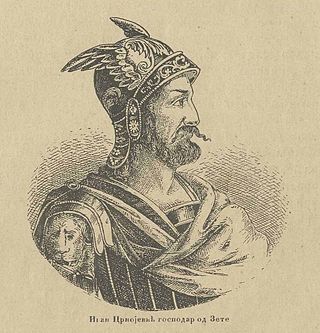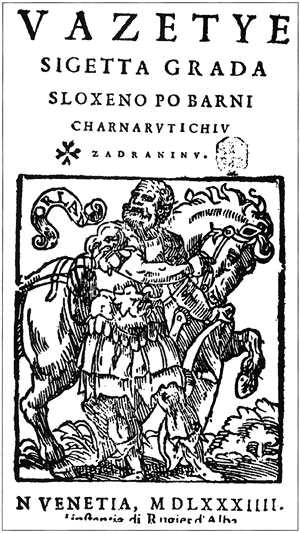
Ivan Crnojević was the lord of Zeta and Serbian leader from 1465 to 1490. Having formed an alliance with the Republic of Venice, he led the Serb resistance against the expanding Ottoman Empire He was successful at first but lost his realm in 1479. He resumed power in 1481 in Žabljak and soon founded Cetinje as the new capital of his state.

Begaljica ) is a rural settlement in the Grocka municipality of eastern Belgrade, Serbia. It is one of 15 settlements of Grocka, situated in its centre, with a population of 8,233 according to the 2011 preliminary census. The village is located at the water source of the Begaljica river, a tributary of the Danube, thus in the southern half of Podunavlje, as well as in the fertile Šumadija region of central Serbia.

Jabuka is a village located on the shores of Tamiš River in the municipality of Pančevo, South Banat District, Vojvodina, Serbia. The village numbers 5,650 people and has the largest ethnic Macedonian population in Serbia by percentage.

The Miroslav Krleža Institute of Lexicography is Croatia's national lexicographical institution. Based in Zagreb, it was established in 1950 as the national lexicographical institute of the Socialist Federal Republic of Yugoslavia. It was renamed after its founder, the Croatian writer Miroslav Krleža, in 1983.

Jevstatije I was the sixth Serbian Archbishop, holding the office from 1279 to 1286. He was born in the Budimlje parish, near Berane in Zeta. He took his monastics vows in Zeta, then left for the Hilandar monastery to study and meditate and, where he later became the hegumen (abbot), succeeding Joanikije, holding the office 1162–65. He left the monastery and became the Bishop of Zeta, and later the Serbian Archbishop in 1279, succeeding Joanikije I. He died on 4 January 1286. His relics were buried in the Monastery of Peć in 1289-1290, after being transferred from the ruined Žiča monastery. The Serbian Orthodox Church commemorates him on 4 January according to the Julian calendar, or 17 January according to the Gregorian calendar.

Stanak is the most common name used to refer to the assembly of nobility in medieval Bosnia. The assembly, in the original Bosančica: Сmɖɴɖк, was also known as the Rusag, Rusag bosanski, Zbor, Sva Bosna or just Bosna, with the officials of the Republic of Ragusa employing several Latin terms as well. The term "stanak sve zemlje Bosne", is first attested in the charter of Tvrtko I in 1354. Its influence peaked between the 1390s and the 1420s. The Serbian historian Sima Ćirković and most other Yugoslav scholars believed that the existence of the stanak proved a unity and feeling of belonging to a Bosnian identity and integrity, but also illustrated weakness of the monarch and decentralization of the state, as argued by American colleague John Van Antwerp Fine, Jr.

Kali is a municipality in Croatia on Ugljan island in Zadar County. In the 2011 census, there were 1,638 inhabitants, 99.39% of whom were Croats. Kali was mentioned in historical documents for the first time in 1299, but archaeological finds on the Orjak hill prove that life existed in this area since prehistoric times.
Pasha Yiğit Bey or Saruhanli Pasha Yiğit Bey was an Ottoman civil and military officer at the end of the 14th and beginning of the 15th century.
Grgur Golubić was a Serbian nobleman who served Emperors Stefan Dušan and Stefan Uroš V as kesar (caesar). He was the son of sevastokrator Branko Mladenović.

Donji Kraji or Donji Krajevi, was a small medieval zemlja of medieval Bosnian state. Its territory was mostly laid within the boundaries of today's Bosanska Krajina in northwestern Bosnia and Herzegovina.
Stefan Balšić ; fl. 1419-40, known as Stefan Maramonte, was a Zetan nobleman. He was the son of Konstantin Balšić and Helena Thopia. Following Konstantin's death in 1402, Helena sought refuge in the Republic of Venice and later lived with her sister Maria Thopia who was married to Philip Maramonte. As a result, the Venetians and Ragusans often referred to Stefan as Maramonte. He was initially a close associate and vassal to Zetan lord Balša III. Balša III and Stefan fought against the Republic of Venice, and Stefan helped in the administration of the land as co-ruler with Balša III, he did however not succeed Balša III. Balša III, who died on 28 April 1421, had decided to pass the rule of Zeta to his uncle, the Serbian Despot Stefan Lazarević. When the Second Scutari War between Venice and Despot Stefan began, he [...]. Stefan left Apulia in the summer of 1426, seeking to take Zeta. During the 1427–28 conflict, Maramonte went to the Ottoman court where he sought the support of Sultan Murad II for his appointment as the Lord of Zeta. There, he met Skanderbeg, who was a hostage at the Ottoman court. Maramonte married Vlajka Kastrioti, the sister of Skanderbeg. Supported by the Ottomans, Maramonte, accompanied by Gojčin Crnojević and Little Tanush, plundered the region around Scutari and Ulcinj, and attacked Drivast in 1429, but failed to capture it. Since his attempts failed, Maramonte surrendered to the Venetians and served as their military officer in the campaigns in Flanders and Lombardia.
Matija Mazarek or Matija Masarek was an 18th-century Catholic priest. In the second half of the 18th century he was the archbishop of the Roman Catholic Diocese of Skopje. His reports to the Vatican are an important source for demography study of his diocese.
The Vilayet of the Black Mountain was an Ottoman administrative unit within the Sanjak of Scutari, consisting of parts of modern-day Montenegro. It was established in the 16th century and existed until 1696. Although claimed by the Ottomans, the area was de facto independent with the Montenegrin tribes, with the support of the Metropolitanate of Cetinje, constantly waging wars against Turks.

The Mileševa printing house was a printing house established in 1544 in the Mileševa monastery near Prijepolje, Ottoman Empire. Three srbulje books were printed in this printing house. Two in 1544 and 1545 and one in 1557.
The Varaždin Generalate, also known as the Windische Grenze in German, was a province of the Military Frontier of the Habsburg monarchy, that existed between 1531 and the 19th century. While the Generalate was originally based in Warasdin (Varaždin), Varaždin County, including the city, was removed from the Military Frontier in the 18th century; the district the Generalate controlled was thereafter centered on Bellowar (Bjelovar), which also briefly acted as its administrative center until it was moved to Zagreb in 1787.

Vazetje Sigeta grada is a 16th century epic poem written between 1568 and 1572 by Brne Karnarutić from Zadar, and deals with the 1566 Siege of Szigetvár defended by Nikola IV Zrinski, based on the writing Podsjedanje i osvojenje Sigeta of Zrinski's scribe and chamberlain, Franjo Črnko.
Živko Jugović was a Serbian painter of religious themes.

Stefan Likić was a Serbian graphic artist and master woodcarver from the first half of the 18th century. His works are on display at the Serbian Orthodox Church Museum in Belgrade.
Dimitrije Posniković was a Serbian iconographer and painter from the 19th century. A student of Dimitrije Avramović, with whom he sometimes collaborated on commissions, Posniković mainly painted icons and frescoes for churches in Serbia.












